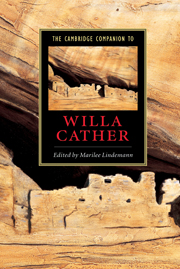Book contents
- Frontmatter
- Introduction
- Part I Contexts and critical issues
- 1 Willa Cather as progressive
- 2 The Cather thesis
- 3 Willa Cather’s American modernism
- 4 Willa Cather and the geography of Jewishness
- 5 Willa Cather and sexuality
- 6 Willa Cather and the performing arts
- 7 Willa Cather and the comic sense of self
- 8 Cather and the short story
- 9 Willa Cather in the country of the ill
- Part II Studies of major works
- Selected bibliography
- Index
2 - The Cather thesis
the American empire of migration
from Part I - Contexts and critical issues
Published online by Cambridge University Press: 28 May 2006
- Frontmatter
- Introduction
- Part I Contexts and critical issues
- 1 Willa Cather as progressive
- 2 The Cather thesis
- 3 Willa Cather’s American modernism
- 4 Willa Cather and the geography of Jewishness
- 5 Willa Cather and sexuality
- 6 Willa Cather and the performing arts
- 7 Willa Cather and the comic sense of self
- 8 Cather and the short story
- 9 Willa Cather in the country of the ill
- Part II Studies of major works
- Selected bibliography
- Index
Summary
“She had heard the new call: ‘Go East, young woman, and grow up with the steel and concrete and electric waves.”
Sinclair Lewis, Gideon Planish (1943)One thing to keep in mind when reading and thinking about Willa Cather is that she was, in both literal and figurative terms, an American pioneer. Her family migrated to Nebraska in the 1880s, a time when people lived in dug-outs and sod-houses (although when young Willa arrived, she had family contacts there to make her settlement relatively easier) and old-timers shared memories of Indian encounters. As an adult, with memories of one uprooting embedded in her consciousness, Cather moved to the Northeast with enthusiasm, finding opportunities for ambitious and intelligent women not in the small towns of Nebraska and the Midwest but in urban centers, amid “the steel and concrete and electric waves” of large cities such as Pittsburgh and New York. There, the figurative pioneer, Cather rose to the top of her field in journalism (in the first decade of the new century she was the editor of McClure's Magazine, one of the most famous and widely read magazines in American history) and then abandoned that career to become a novelist. In her fiction she did what is understood to be impossible: she wrote novels embraced as art by critics and read with passion and devotion by the popular reading public.
- Type
- Chapter
- Information
- The Cambridge Companion to Willa Cather , pp. 35 - 50Publisher: Cambridge University PressPrint publication year: 2005



